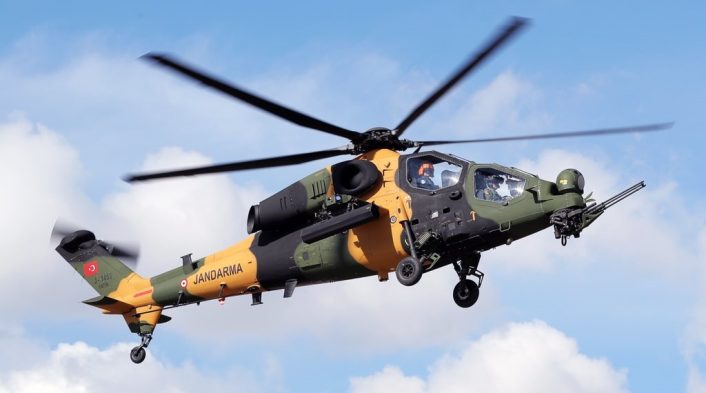The two helicopters struck targets in coordination with commandos on the ground, flying between mountains and at treetop level in the valleys.
The Turkish Gendarmerie (or Jandarma) published on its YouTube channel an interesting 360° video showing two of its T129 ATAK helicopters during an operational Close Air Support mission. The video, recorded from the pilot’s perspective, starts by specifying that the operation took place in June 2020 near Çeltikli, in the Bitlis province (Eastern Turkey).
According to Turkish media, the two helicopters, identified in the video as “J-1071 Alparslan” and “J-1453 Fatih”, acted in coordination with Jandarma’s commandos on the ground fighting unspecified militants, probably from the Kurdistan Workers’ Party (PKK), known for operating in the area.
The two helicopters can be seen taking off from a base near Tatvan, on the shores of Lake Van, making their way through the mountains at low altitude to reach the Çeltikli area, performing two attack runs with 70 mm unguided rockets and a final strafe with the M197 20 mm cannon, before returning to the base by flying Nap-Of-the-Earth (NOE) in the valleys and then again through the mountains. An interesting fact from the video is that, during the attack runs, the images from the gunner’s displays are superimposed over the windshield to show the rounds hitting their targets, which by the way looks like they were hiding in dense vegetation.
Nap-Of-the-Earth is a very low-level flight, used particularly by helicopters to reduce as much as possible the exposition to threats and surface-to-air fire, flying at treetop level or even lower, as we can see at some point in the video. This type of flight is often used in films as it’s highly dynamic (and dangerous, leaving to place for distractions to the pilots) and made also a notorious appearance in the 2002 film “We Were Soldiers” with numerous UH-1 Iroquois helicopters flying NOE to insert Air Cavalry soldiers in the Ia Drang Valley.
The Turkish Aerospace Industries/Agusta Westland (now Leonardo) T129 ATAK is an heavily modified version of the Italian-made AW-129 “Mangusta” attack helicopter (designated AH-129D in the latest upgrade for the Italian Army), with Turkish avionics, weapons and airframe modifications. The program goes back to 2007, when Turkey was looking for a new tactical reconnaissance and attack helicopter for its armed forces. As per Turkish policy, the helicopters had to be produced locally with full marketing and intellectual property rights, meaning that the helicopter is now a totally different machine compared to the AW-129.

Currently, 60 helicopters were delivered to the Turkish Army and 18 to the Gendarmerie, with one lost in combat in 2018. These helicopters are in a so called “Phase 1” configuration and designated as T129Bs, equipped with missile warning system, countermeasures dispensers and DIRCM, and capable of firing laser-guided rockets and missiles. “Phase 2” configuration will reportedly add a laser warning receiver and new electronic warfare systems, also increasing the helicopter’s payload.
The T129 was also ordered by Pakistan and the Philippines, however the orders were put on hold after the F-35/S-400 affair which resulted in Turkey being expelled from the F-35 program and the application of the CAATSA (Countering America’s Adversaries Through Sanctions Act) resulting, among all things, in the block of the import clearance of the LHTEC (joint venture between the Rolls-Royce and Honeywell) T800-4A turboshaft engine that powers the helicopter. The Philippines are now are now evaluating the AH-1Z Viper and AH-64E Apache Guardian, while Pakistan, after being denied both the AH-1Z and the T-129, is now evaluating the Chinese CAIC Z-10 attack helicopter.
Thank you to The Aviationist’s friend Arda Mevlutoglu (@orko_8) for sending the video over to us!









